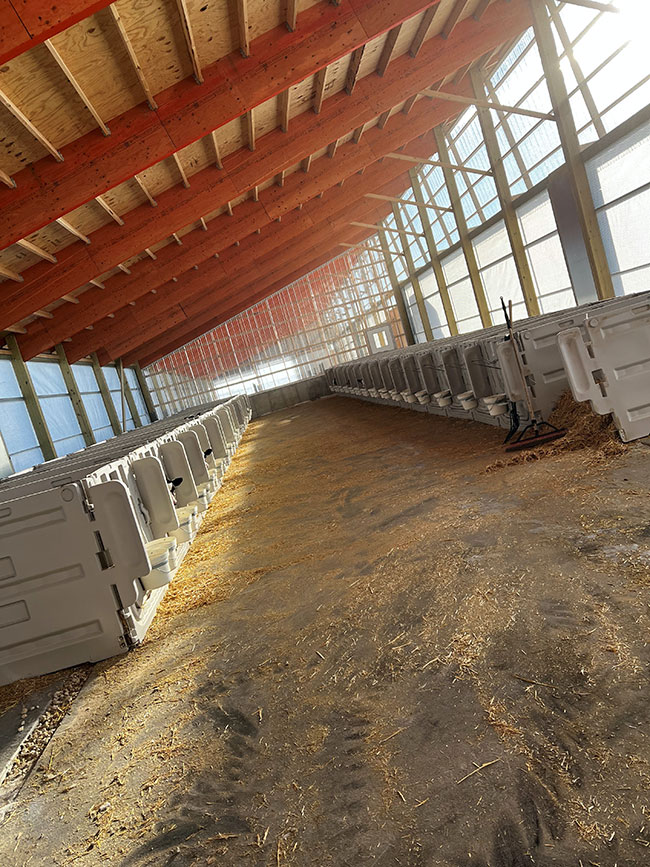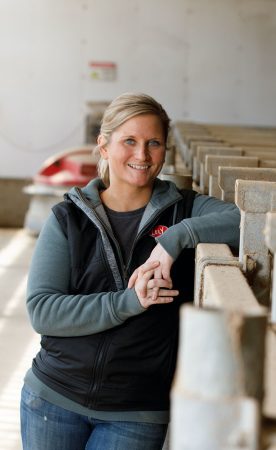
Features
Applications
Beef
Dairy
Livestock Production
Production
Enhancing the essentials
Calf health tools contribute to healthy animals and create ripples of increased production, farm growth and better economic viability
April 7, 2022 by Ronda Payne
 The McAllister Family Dairy is home to 280 milking cows. All photos courtesy of Megan Kregel.
The McAllister Family Dairy is home to 280 milking cows. All photos courtesy of Megan Kregel. Food, water, shelter, cleanliness. These are the essential aspects of raising a healthy calf. But each element has so much more to it than first assumed. In fact, considering the necessary investments in livestock and their direct correlation to revenue, doing just the basics is no longer enough in a rapidly changing agricultural marketplace.
Jennifer Bentley, dairy field specialist with Iowa State University grew up in dairy farming and brought that passion to her research around raising happier, healthier calves.
“Nutrition, housing and environment are all key factors in reaching these goals,” she says. “Simple tracking and reviewing of records on an individual farm basis could help in determining if calves could be healthier.”
Setting and watching checkpoints for health
Pre-weaning is a critical time to observe markers that indicate calf health, she says.
“Monitoring calf health and growth is important to understand if calves are going through the pre-weaning stage effectively,” she says. Each farm should establish its own growth indicators based on the herd’s average body size at maturity. “A goal would be to double calves’ birthweight by 56 days of age, around the time of weaning,” she says.
She also points to the Dairy Calf and Heifer Association Gold Standards as a resource for understanding key levels for certain conditions. For example, treatment rates for pneumonia in calves should be less than 10 percent and scours (runny, discolored stool) should be less than 15 percent.
The basics with a twist
In New Vienna, Iowa, Megan Kregel, is a sixth-generation dairy farmer managing the calves of the 280-milk-cow herd at McAllister Family Dairy. Her fiance Ted McAllister and his brother own and operate the farm. She’s aware of the importance of providing the daily basics to calves to ensure their long-term success, but she’s also willing to incorporate new elements into that management if she sees a benefit.
“Monitoring daily consumption is always a key indicator of calf health,” she says. “Feeding calves individually allows us to watch drinking speed, water consumption, feed intake and more. We also pay close attention to their manure or any other changes in behaviour. The basics always apply to having happy, healthy calves: keeping them dry, well-bedded, well-ventilated and proper nutrition.”
With a brand-new calf barn now housing the calves, she’s excited about bringing in a milk taxi for feeding. The taxi is a computerized, mobile milk tank that has individual settings for each pen allowing farmers to observe how the calf behaves rather than being overly caught up in the details of the feeding itself.
“This new-to-us technology will allow for better consistency and improved efficiency,” she adds.
Science has also taken a significant role on the McAllister family farm. Females are all genomic tested which provides a higher level of valuable information on the genetic potential of each animal.
And Kregel will also be incorporating Bentley’s tip about weight as a monitoring tool.
“We will be implementing weighing calves in order to ensure we are reaching key growth benchmarks,” says Kregel.

Megan Kriegel knows the importance of feeding calves individually and monitoring their habits closely.
Managing the factors that can’t be controlled
Humans can control a lot of things, but weather isn’t one of them. How farmers respond to it is the key question as it will impact calf health.
“Weather can play a major role in the health and growth of calves and weather conditions need to be taken into consideration to make sure calves are always receiving adequate nutrients to both stay healthy and grow,” says Bentley.
Kregel says the Midwest can be particularly brutal in terms of adjustments necessary to deal with extreme heat and cold. “From the highest of highs to the lowest of lows, we have to deal with all of it in the Midwest,” she says. “We have to keep calves dry year-round in times of humidity and sub-zero temps.”
Bentley has created an article on cold weather calf care as well as one on heat stress to help farmers better understand what to do when the mercury climbs or dips to extremes. Within her cold weather care article, she explains that calves do best in what is known as the thermoneutral zone – a temperature range of 50 to 78 degrees Fahrenheit where they won’t use any additional energy to maintain their body temperature. One-month old calves can manage a wider range of 32 to 78 degrees.
She advises that when the temperature reaches zero degrees, calves should be fed 50 percent more calories to maintain their body temperature. With just three to four percent body fat at birth, these animals don’t have a lot of room for loss. Too few calories in a cold weather event may contribute to illnesses and poor growth.
“Providing higher energy intakes [to] calves during colder weather does have a long-lasting impact,” she says in her cold weather article.
She refers to a study from Cornell University that says that a one-pound daily weight gain difference during preweaning resulted in 850 pounds more milk in the calf’s first lactation. Over three lactations, the total is 2,280 pounds. This study proves that keeping calves warm, while ensuring their ongoing nutritional needs are met, will create a higher production operation.
Additional tips she advises for cold weather management:
- In the first 24 hours, calves need a warm environment like a warming box or heated room to enable drying and prevent chilling. Cold conditions also make colostrum even more important.
- To increase food energy, she recommends increasing from two to three daily feedings, increasing volume fed, increasing powder in the same volume of water or switching to a higher fat content milk replacer or pasteurized milk.
- Feed milk should be warmed to between 101 and 105 degrees at the time of feeding.
- Fresh warm water should be provided to up to 30 minutes after each feeding.
- Incorporate starter in small amounts after three days of age.
- At under three weeks old, calves should have a calf jacket that is adjusted regularly as the calf grows.
- Take a moment to experience their environment. Kneel in the bedding and note if your knees get wet. Observe air quality and fresh air movement to maximize ammonia removal while decreasing drafts.
When the heat ramps up
High heat events will lead to heat stress in calves and the resulting dehydration and reduced feed intake can compromise immune systems and delay growth. Above 78 degrees Fahrenheit (with consideration of the impacts of humidity levels) a calf may start experiencing heat stress.
Signs of heat stress Bentley notes include: reduced movement, faster breathing rate, open-mouthed panting, decreased feed intake and increased water consumption. •